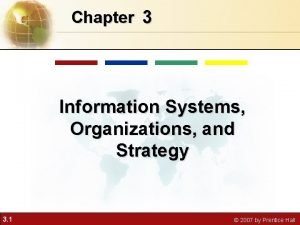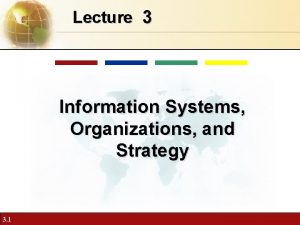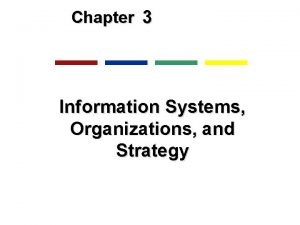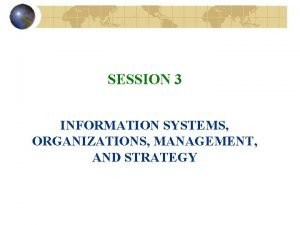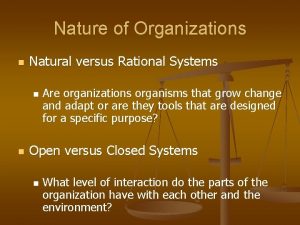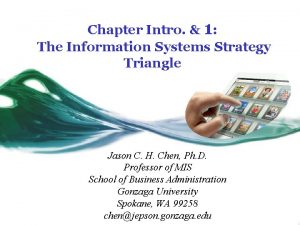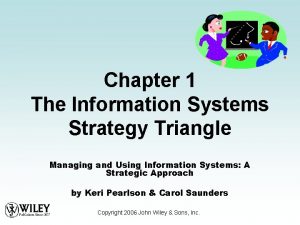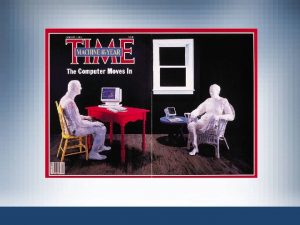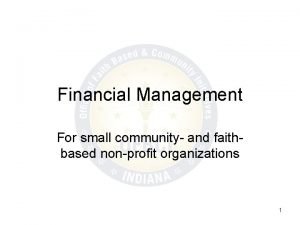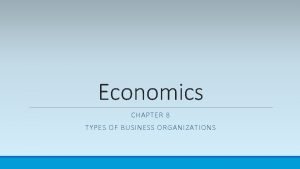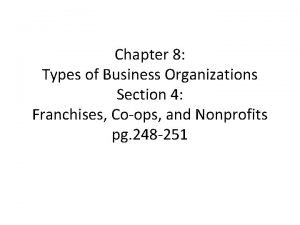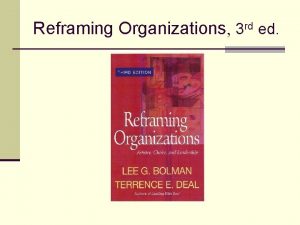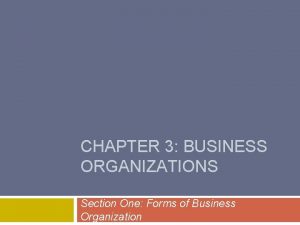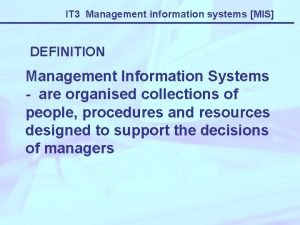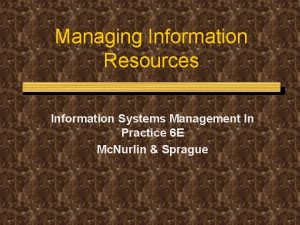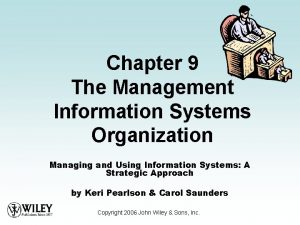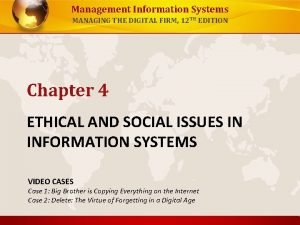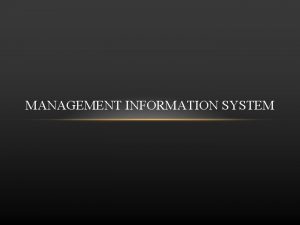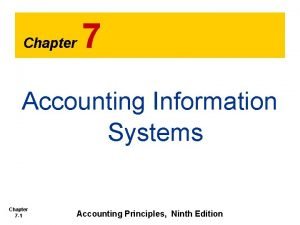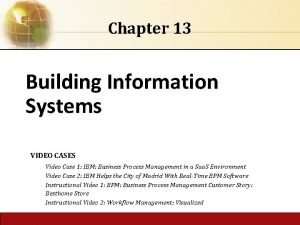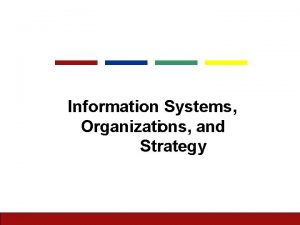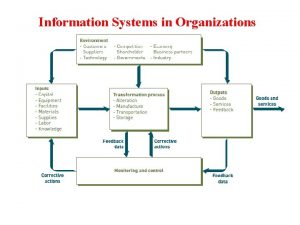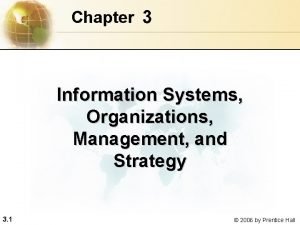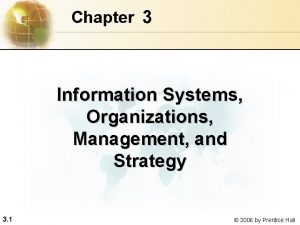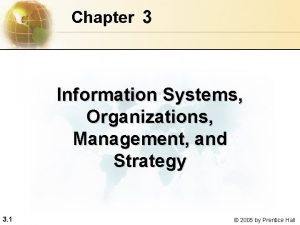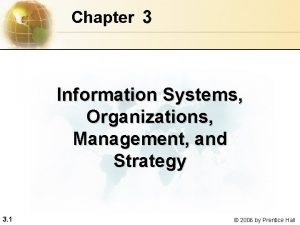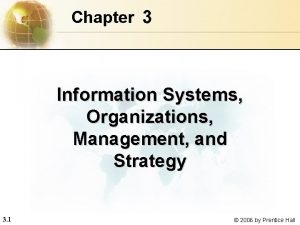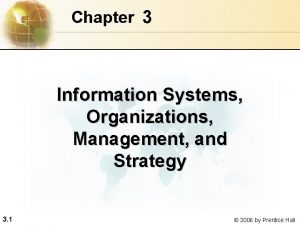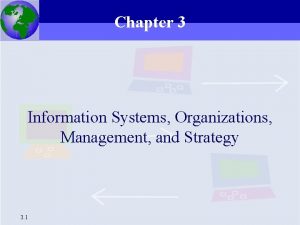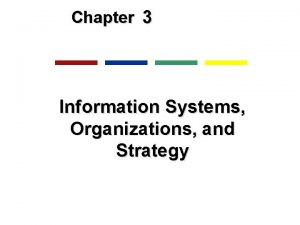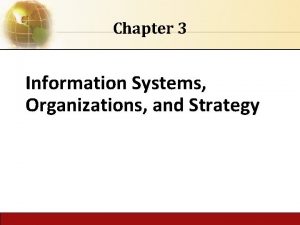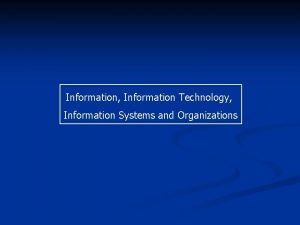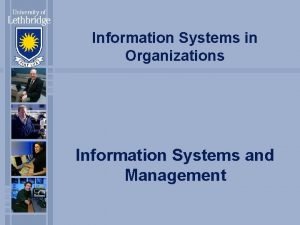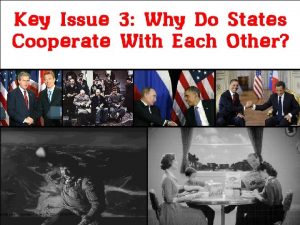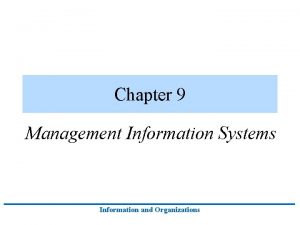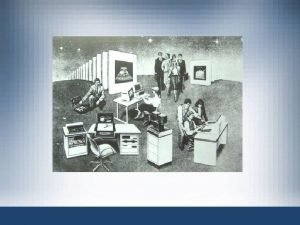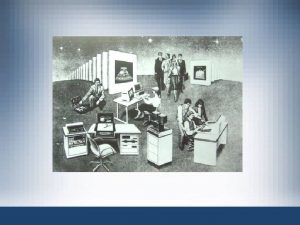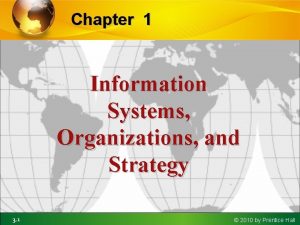Chapter 3 Information Systems Organizations and Strategy Management



































- Slides: 35

Chapter 3 Information Systems, Organizations, and Strategy

Management Information Systems Chapter 3 Information Systems, Organizations, and Strategy Organizations and Information Systems

Management Information Systems Chapter 3 Information Systems, Organizations, and Strategy Organizations and Information Systems The Two-Way Relationship Between Organizations and Information Technology • Information technology and organizations influence one another • Complex relationship influenced by organization’s structure, business processes, politics, culture, environment, and management decisions Figure 3 -1

Management Information Systems Chapter 3 Information Systems, Organizations, and Strategy Organizations and Information Systems • What is an organization? • Technical definition: • Stable, formal social structure that takes resources from environment and processes to produce outputs. • A formal legal entity with internal rules and procedures, as well as a social structure • Behavioral definition: • A collection of rights, privileges, obligations, and responsibilities that is delicately balanced over a period of time through conflict and conflict resolution

Management Information Systems Chapter 3 Information Systems, Organizations, and Strategy Organizations and Information Systems The Technical View of Organizations What is an organization? Technical definition: • Stable, formal social structure that takes resources from environment and processes to produce outputs. • A formal legal entity with internal rules and procedures, as well as a social structure In the microeconomic definition of organizations, capital and labor (the primary production factors provided by the environment) are transformed by the firm through the production process into products and services (outputs to the environment). The products and services are consumed by the environment, which supplies additional capital and labor as inputs in the feedback loop. Figure 3 -2

Management Information Systems Chapter 3 Information Systems, Organizations, and Strategy Organizations and Information Systems The Behavioral View of Organizations What is an organization? Behavioral definition: A collection of rights, privileges, obligations, and responsibilities that is delicately balanced over a period of time through conflict and conflict resolution Figure 3 -3 The behavioral view of organizations emphasizes group relationships, values, and structures.

Management Information Systems Chapter 3 Information Systems, Organizations, and Strategy Organizations and Information Systems • Features of organizations • All modern organizations share some characteristics, such as: • Use of hierarchical structure • Accountability, authority in system of impartial decision-making • Adherence to principle of efficiency • Other features include: Routines and business processes and organizational politics, culture, environments and structures

Management Information Systems Chapter 3 Information Systems, Organizations, and Strategy Organizations and Information Systems • Routines and business processes • Routines (standard operating procedures) • Precise rules, procedures, and practices developed to cope with virtually all expected situations • Business processes: Collections of routines • Business firm: Collection of business processes

Management Information Systems Chapter 3 Information Systems, Organizations, and Strategy Organizations and Information Systems Routines, Business Processes, and Firms All organizations are composed of individual routines and behaviors, a collection of which make up a business process. A collection of business processes make up the business firm. New information system applications require that individual routines and business processes change to achieve high levels of organizational performance. Figure 3 -4

Management Information Systems Chapter 3 Information Systems, Organizations, and Strategy Organizations and Information Systems • Organizational politics • Divergent viewpoints lead to political struggle, competition, and conflict • Political resistance greatly hampers organizational change

Management Information Systems Chapter 3 Information Systems, Organizations, and Strategy Organizations and Information Systems • Organizational environments: • Organizations and environments have a reciprocal relationship • Organizations are open to, and dependent on, the social and physical environment • Organizations can influence their environments • Environments generally change faster than organizations • Information systems can be instrument of environmental scanning, act as a lens

Management Information Systems Chapter 3 Information Systems, Organizations, and Strategy Organizations and Information Systems Environments and Organizations Have a Reciprocal Relationship Environments shape what organizations can do, but organizations can influence their environments and decide to change environments altogether. Information technology plays a critical role in helping organizations perceive environmental change and in helping organizations act on their environment. Figure 3 -5

Management Information Systems Chapter 3 Information Systems, Organizations, and Strategy Organizations and Information Systems • Organizational structure • Five basic kinds of structure • Entrepreneurial: Small start-up business • Machine bureaucracy: Midsize manufacturing firm • Divisionalized bureaucracy: Fortune 500 firms • Professional bureaucracy: Law firms, school systems, hospitals • Adhocracy: Consulting firms

Management Information Systems Chapter 3 Information Systems, Organizations, and Strategy How Information Systems Impact Organizations and Business Firms • Economic impacts • IT changes relative costs of capital and the costs of information • Information systems technology is a factor of production, like capital and labor • IT affects the cost and quality of information and changes economics of information • Information technology helps firms contract in size because it can reduce transaction costs (the cost of participating in markets). Outsourcing expands

Management Information Systems Chapter 3 Information Systems, Organizations, and Strategy How Information Systems Impact Organizations and Business Firms • Transaction cost theory • Firms seek to economize on cost of participating in market (transaction costs) • IT lowers market transaction costs for firm, making it worthwhile for firms to transact with other firms rather than grow the number of employees

Management Information Systems Chapter 3 Information Systems, Organizations, and Strategy How Information Systems Impact Organizations and Business Firms The Transaction Cost Theory of the Impact of Information Technology on the Organization Firms traditionally grew in size to reduce transaction costs. IT potentially reduces the costs for a given size, shifting the transaction cost curve inward, opening up the possibility of revenue growth without increasing size, or even revenue growth accompanied by shrinking size. Figure 3 -6

Management Information Systems Chapter 3 Information Systems, Organizations, and Strategy How Information Systems Impact Organizations and Business Firms • Agency theory: • Firm is nexus of contracts among selfinterested parties requiring supervision • Firms experience agency costs (the cost of managing and supervising) which rise as firm grows • IT can reduce agency costs, making it possible for firms to grow without adding to the costs of supervising, and without adding employees

Management Information Systems Chapter 3 Information Systems, Organizations, and Strategy How Information Systems Impact Organizations and Business Firms The Agency Cost Theory of the Impact of Information Technology on the Organization As firms grow in size and complexity, traditionally they experience rising agency costs. IT shifts the agency cost curve down and to the right, enabling firms to increase size while lowering agency costs. Figure 3 -7

Management Information Systems Chapter 3 Information Systems, Organizations, and Strategy How Information Systems Impact Organizations and Business Firms • Organizational and behavioral impacts • IT flattens organizations • Decision-making pushed to lower levels • Fewer managers needed (IT enables faster decisionmaking and increases span of control) • Postindustrial organizations • Organizations flatten because in postindustrial societies, authority increasingly relies on knowledge and competence rather than formal positions

Management Information Systems Chapter 3 Information Systems, Organizations, and Strategy How Information Systems Impact Organizations and Business Firms Flattening Organizations Information systems can reduce the number of levels in an organization by providing managers with information to supervise larger numbers of workers and by giving lower-level employees more decision-making authority. Figure 3 -8

Management Information Systems Chapter 3 Information Systems, Organizations, and Strategy How Information Systems Impact Organizations and Business Firms • Organizational resistance to change • Information systems become bound up in organizational politics because they influence access to a key resource -- information • Information systems potentially change an organization’s structure, culture, politics, and work • Most common reason for failure of large projects is due to organizational & political resistance to change

Management Information Systems Chapter 3 Information Systems, Organizations, and Strategy How Information Systems Impact Organizations and Business Firms Organizational Resistance and the Mutually Adjusting Relationship Between Technology and the Organization Implementing information systems has consequences for task arrangements, structures, and people. According to this model, to implement change, all four components must be changed simultaneously. Figure 3 -9

Management Information Systems Chapter 3 Information Systems, Organizations, and Strategy How Information Systems Impact Organizations and Business Firms • Central organizational factors to consider when planning a new system: • Environment • Structure • Hierarchy, specialization, routines, business processes • Culture and politics • Type of organization and style of leadership • Main interest groups affected by system; attitudes of end users • Tasks, decisions, and business processes the system will assist

Management Information Systems Chapter 3 Information Systems, Organizations, and Strategy Using Information Systems to Achieve Competitive Advantage • Why do some firms become leaders within their industry? • Michael Porter’s competitive forces model • Provides general view of firm, its competitors, and environment • Five competitive forces shape fate of firm • • • Traditional competitors New market entrants Substitute products and services Customers Suppliers

Management Information Systems Chapter 3 Information Systems, Organizations, and Strategy Using Information Systems to Achieve Competitive Advantage Porter’s Competitive Forces Model In Porter’s competitive forces model, the strategic position of the firm and its strategies are determined not only by competition with its traditional direct competitors but also by four forces in the industry’s environment: new market entrants, substitute products, customers, and suppliers. Figure 3 -10

Management Information Systems Chapter 3 Information Systems, Organizations, and Strategy Using Information Systems to Achieve Competitive Advantage • Traditional competitors • All firms share market space with competitors who are continuously devising new products, services, efficiencies, switching costs • New market entrants • Some industries have high barriers to entry, e. g. computer chip business • New companies have new equipment, younger workers, but little brand recognition

Management Information Systems Chapter 3 Information Systems, Organizations, and Strategy Using Information Systems to Achieve Competitive Advantage • Substitute products and services • Substitutes customers might use if your prices become too high, e. g. i. Tunes substitutes for CDs • Customers • Can customers easily switch to competitor’s products? Can they force businesses to compete on price alone in transparent marketplace? • Suppliers • Market power of suppliers when firm cannot raise prices as fast as suppliers

Management Information Systems Chapter 3 Information Systems, Organizations, and Strategy Using Information Systems to Achieve Competitive Advantage • Four generic strategies for dealing with competitive forces, enabled by using IT • Low-cost leadership • Product differentiation • Focus on market niche • Strengthen customer and supplier intimacy

Management Information Systems Chapter 3 Information Systems, Organizations, and Strategy Using Information Systems to Achieve Competitive Advantage • Low-cost leadership • produce products and services at a lower price than competitors while enhancing quality and level of service. • E. g. Wal-Mart, Dell • Product differentiation • Enable new products or services, greatly change customer convenience and experience • E. g. Google, Apple i. Phone, PING, Easy. Paisa

Management Information Systems Chapter 3 Information Systems, Organizations, and Strategy Using Information Systems to Achieve Competitive Advantage • Focus on market niche • Use information systems to enable a focused strategy on a single market niche; specialize. • E. g. Land’s End • Strengthen customer and supplier intimacy’ • Use information systems to develop strong ties and loyalty with customers and suppliers; increase switching costs • E. g. Chrysler, Amazon

Management Information Systems Chapter 3 Information Systems, Organizations, and Strategy Using Information Systems to Achieve Competitive Advantage • The Internet’s impact on competitive advantage • Transformation, destruction, threat to some industries • E. g. travel agency, printed encyclopedia, newspaper • Competitive forces still at work, but rivalry more intense • Universal standards allow new rivals, entrants to market • New opportunities for building brands and loyal customer bases

Management Information Systems Chapter 3 Information Systems, Organizations, and Strategy Using Information Systems to Achieve Competitive Advantage • Business value chain model • Views firm as series of activities that add value to products or services • Highlights activities where competitive strategies can best be applied • Primary activities vs. secondary activities • At each stage, determine how information systems can improve operational efficiency and improve customer and supplier intimacy • Utilize benchmarking, industry best practices

Management Information Systems Chapter 3 Information Systems, Organizations, and Strategy Using Information Systems to Achieve Competitive Advantage The Value Chain Model This figure provides examples of systems for both primary and support activities of a firm and of its value partners that can add a margin of value to a firm’s products or services. Figure 3 -11

Management Information Systems Chapter 3 Information Systems, Organizations, and Strategy Using Information Systems to Achieve Competitive Advantage Amazon. com is an early e-commerce leader that has adjusted it strategy multiple times. It is trying to become a onestop source for online shoppers.

Management Information Systems Chapter 3 Information Systems, Organizations, and Strategy Using Systems for Competitive Advantage: Management Issues • Sustaining competitive advantage • Because competitors can retaliate and copy strategic systems, competitive advantage is not always sustainable; systems may become tools for survival • Performing strategic systems analysis • What is structure of industry? • What are value chains for this firm? • Managing strategic transitions • Adopting strategic systems requires changes in business goals, relationships with customers and suppliers, and business processes
 Chapter 3 information systems organizations and strategy
Chapter 3 information systems organizations and strategy Information systems organizations and strategy
Information systems organizations and strategy Information systems, organizations, and strategy
Information systems, organizations, and strategy Information systems, organizations, and strategy
Information systems, organizations, and strategy Information systems organizations and strategy
Information systems organizations and strategy Chapter 1 introduction to management and organizations
Chapter 1 introduction to management and organizations Management information system chapter 1
Management information system chapter 1 Introduction to management information system
Introduction to management information system Rational systems
Rational systems Information systems strategy matrix example
Information systems strategy matrix example Information system triangle
Information system triangle Information
Information Chapter 4 ethical and social issues in information systems
Chapter 4 ethical and social issues in information systems 4 components of an information system
4 components of an information system Faith based financial accounting software
Faith based financial accounting software Management in criminal justice organizations
Management in criminal justice organizations Chapter 8 business organizations
Chapter 8 business organizations Section 4 other organizations
Section 4 other organizations Chapter 8 business organizations
Chapter 8 business organizations Reframing organizations chapter 3 summary
Reframing organizations chapter 3 summary Chapter 3 business organizations
Chapter 3 business organizations Levels of management information system
Levels of management information system Mis manager meaning
Mis manager meaning Information systems management in practice
Information systems management in practice Vertical
Vertical Management information systems wiley
Management information systems wiley Management information systems 13th edition
Management information systems 13th edition Management information systems effy oz
Management information systems effy oz Introduction to management information systems 5th edition
Introduction to management information systems 5th edition Management information systems managing the digital firm
Management information systems managing the digital firm What is management information systems
What is management information systems Chapter 8 securing information systems
Chapter 8 securing information systems Chapter 8 securing information systems
Chapter 8 securing information systems Chapter 7 accounting information systems
Chapter 7 accounting information systems Chapter 7 accounting information systems
Chapter 7 accounting information systems Chapter 13 building information systems
Chapter 13 building information systems

